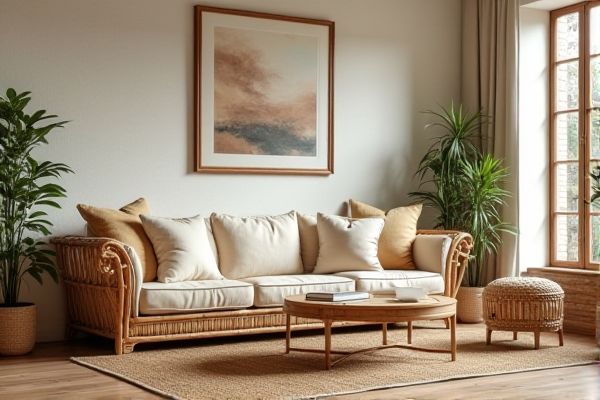
Cane furniture offers a lightweight and flexible design with a classic, woven texture, while bamboo furniture provides exceptional durability and eco-friendly benefits due to its fast-growing nature. Explore the rest of the article to discover which option best suits your style and sustainability preferences.
Table of Comparison
| Feature | Cane Furniture | Bamboo Furniture |
|---|---|---|
| Material | Rattan vine from palm family | Fast-growing grass, hollow stem |
| Durability | Moderate; prone to wear and breakage | High; strong and flexible |
| Weight | Lightweight | Lightweight to medium weight |
| Maintenance | Requires regular cleaning and protection from moisture | Low maintenance; resistant to moisture and pests |
| Eco-friendliness | Renewable, biodegradable | Sustainable, rapidly renewable, biodegradable |
| Design Style | Traditional, intricate patterns | Modern, minimalist or rustic |
| Cost | Moderate price range | Varies; often affordable to mid-range |
| Common Uses | Indoor chairs, tables, decorative items | Furniture, flooring, panels, outdoor use |
Introduction to Cane and Bamboo Furniture
Cane furniture, crafted from the outer bark of rattan vines, offers lightweight durability and intricate weaving patterns ideal for indoor and outdoor use. Bamboo furniture, made from fast-growing bamboo stalks, provides exceptional strength, eco-friendliness, and natural resistance to pests and moisture. Both materials are sustainable choices with distinct textures and structural properties suited for various furniture styles.
Key Differences Between Cane and Bamboo
Cane furniture is crafted from the rattan vine, known for its flexibility, lightweight nature, and intricate weaving patterns, offering a delicate and traditional aesthetic. Bamboo furniture, made from the fast-growing grass species, provides exceptional strength, durability, and a modern, eco-friendly appeal with its solid, sturdy structure. Choosing between cane and bamboo furniture depends on your preference for either the elegant texture of cane or the sustainable robustness of bamboo.
Material Source and Sustainability
Cane furniture is made from rattan, a fast-growing vine native to tropical regions, prized for its durability and flexibility. Bamboo furniture utilizes bamboo stalks, which are among the fastest-growing plants globally, enabling rapid replenishment and minimal environmental impact. Your choice between cane and bamboo furniture should consider the sustainable harvesting practices and the regenerative capabilities of both materials.
Durability and Strength Comparison
Cane furniture, made from the rattan plant, offers moderate durability and flexibility but is prone to wear with heavy use and exposure to moisture. Bamboo furniture stands out for its exceptional strength and resilience, often surpassing many hardwoods in tensile strength, making it highly durable for both indoor and outdoor settings. The dense, fibrous structure of bamboo ensures long-lasting support and resistance to cracking, while cane requires regular maintenance to sustain its integrity.
Design Versatility and Aesthetic Appeal
Cane furniture offers intricate weaving patterns that create a classic, airy look suitable for both traditional and contemporary interiors, while bamboo furniture boasts sleek, minimalist lines ideal for modern and eco-friendly designs. The natural flexibility of cane allows artisans to craft detailed, curved shapes, enhancing its decorative appeal, whereas bamboo's strong, straight stalks provide structural simplicity and a clean, geometric aesthetic. Both materials bring organic warmth and texture to spaces, but cane excels in ornamental variation, and bamboo stands out for its sustainable, streamlined elegance.
Maintenance and Care Requirements
Cane furniture requires regular dusting and occasional polishing to maintain its flexibility and prevent cracking, especially in dry climates. Bamboo furniture demands less frequent maintenance, thriving with just periodic cleaning and protection from excessive moisture to avoid mold growth. Your choice should consider how much time you can dedicate to upkeep while ensuring longevity and aesthetic appeal.
Comfort and Practicality
Cane furniture offers lightweight flexibility and breathable support, making it ideal for comfortable seating with natural ventilation. Bamboo furniture stands out for its remarkable durability and strength, providing long-lasting practicality and resistance to wear and moisture. Both materials contribute eco-friendly options, but cane excels in comfort, while bamboo prioritizes structural robustness.
Cost Considerations
Cane furniture typically costs more due to the labor-intensive weaving process and the durability of natural rattan fibers, making it a long-term investment for your home. Bamboo furniture is generally more affordable, benefiting from faster growth cycles and sustainable harvesting methods that reduce production expenses. Choosing between cane and bamboo furniture depends on your budget and preference for durability versus cost efficiency.
Popular Uses and Applications
Cane furniture is widely used in traditional and vintage-inspired interiors, offering lightweight and breathable seating ideal for patios, sunrooms, and conservatories. Bamboo furniture is favored for its strength and sustainability, making it popular in modern eco-friendly designs, outdoor settings, and contemporary urban homes. Both materials are commonly used in chairs, tables, and storage units, with bamboo often chosen for durability and cane for intricate woven patterns.
Choosing the Right Furniture for Your Space
Cane furniture offers lightweight durability and a classic, airy appearance perfect for indoor and outdoor settings, while bamboo furniture provides exceptional strength and eco-friendly sustainability with a modern aesthetic. Your choice depends on the specific needs of your space, such as exposure to moisture, maintenance requirements, and desired style. Selecting the right material ensures long-lasting beauty and functionality tailored to your lifestyle.
 homyna.com
homyna.com